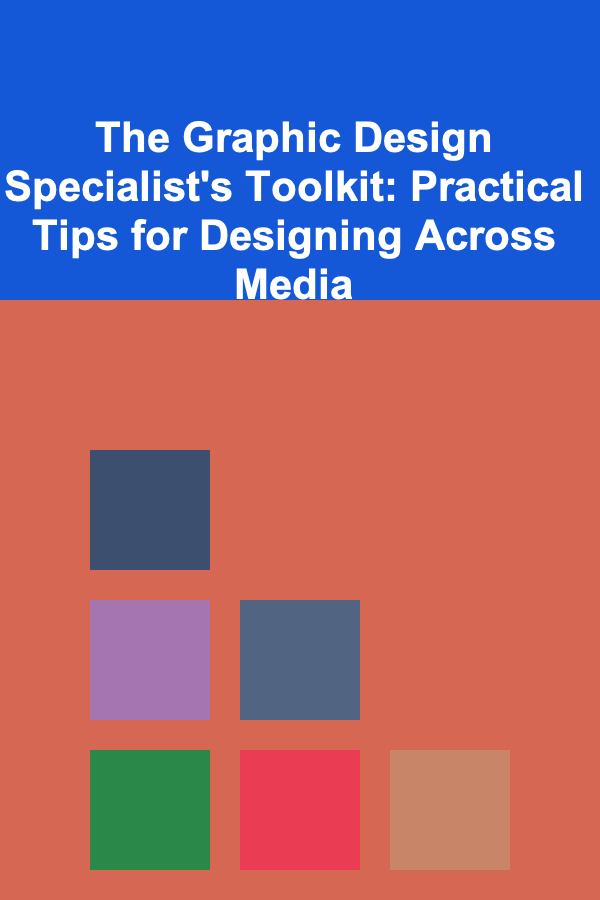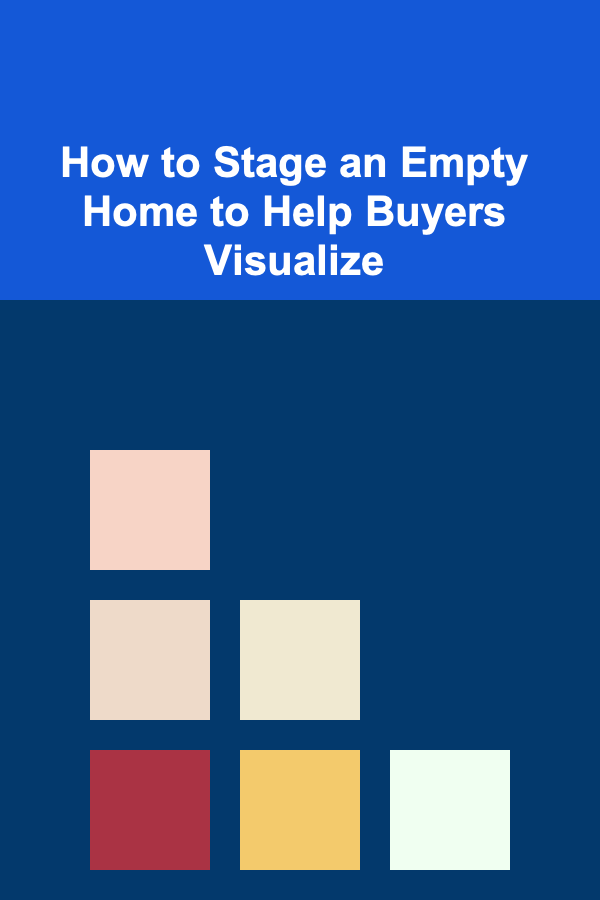
The Graphic Design Specialist's Toolkit: Practical Tips for Designing Across Media
ebook include PDF & Audio bundle (Micro Guide)
$12.99$11.99
Limited Time Offer! Order within the next:

Graphic design is a multidisciplinary art form that requires technical expertise, creative vision, and a deep understanding of the medium you are designing for. Whether you're designing for print, digital platforms, or emerging technologies, a graphic design specialist needs to be adaptable and knowledgeable about the tools, techniques, and principles that apply to various media formats.
In this comprehensive guide, we'll explore practical tips and strategies that will help you as a graphic design specialist excel across different types of media. By mastering the nuances of each medium, you'll be able to create designs that are not only aesthetically pleasing but also functional and engaging for the intended audience.
Understanding Media-Specific Constraints
Print Design: The Power of Tangibility
Print design encompasses a variety of formats, including posters, brochures, magazines, business cards, and billboards. While designing for print, there are specific constraints and considerations you need to keep in mind:
- Resolution: Print materials require high resolution, typically 300 DPI (dots per inch), to ensure the design looks sharp and professional. Unlike digital designs that are measured in pixels, print designs are outputted in physical form, so resolution matters.
- Color Models: The most common color model for print is CMYK (cyan, magenta, yellow, and key/black). Understanding the differences between RGB (for digital screens) and CMYK is crucial to ensuring color consistency. Colors may appear differently when printed, so it's essential to test and proof before the final print run.
- Bleed and Margins: When designing for print, it's important to account for bleed -- the area outside of the trim edge. This ensures that there are no white borders when the material is trimmed. A typical bleed area is about 1/8 inch (3mm).
- Typography: Print design gives you more control over typography. Use fonts that are legible and suited for printed materials. Consider the medium (e.g., a business card vs. a billboard) and how the typography will scale.
Tip for Print Design:
Before finalizing your design for print, always print a proof. This step helps you catch any errors in color, resolution, or layout that may not be visible on screen.
Digital Design: The Flexible and Interactive Medium
Digital design is the most common form of graphic design in today's world, encompassing web design, app interfaces, social media graphics, and more. When designing for digital media, the constraints and considerations are slightly different from print design:
- Resolution and Screen Size: Digital designs must be optimized for different screen sizes and resolutions. While web and mobile designs can be relatively flexible, you need to ensure that images, typography, and layouts look good on various devices, from smartphones to desktops.
- Color Models: Digital designs use the RGB color model (red, green, blue), which is based on the colors of light. Understanding how RGB works is key to achieving vibrant colors on screen.
- Responsive Design: In the digital world, it's essential to design with responsiveness in mind. Your design should be adaptable to different screen sizes and orientations, whether it's on a desktop, tablet, or mobile device.
- User Experience (UX) and User Interface (UI): Digital design places a significant emphasis on user experience. Make sure your design is functional, intuitive, and easy to navigate. Consider how the user interacts with the design, especially when creating websites and mobile apps.
Tip for Digital Design:
Use tools like Figma , Sketch , and Adobe XD to create interactive prototypes. These tools allow you to simulate how users will interact with your design, giving you insight into potential usability issues before the design is finalized.
Motion Graphics and Animation: Adding Dynamic Elements
Motion graphics is a powerful way to engage an audience by adding movement and interaction to a design. Whether you're working on social media posts, explainer videos, or title sequences, motion design is all about storytelling through animation. Key considerations for motion graphics include:
- Timing and Pacing: When creating motion graphics, the timing of each animation is critical. You must ensure that animations are smooth and well-paced to create a compelling visual narrative.
- File Formats and Compression: Motion graphics are often delivered in formats such as MP4, MOV, or GIF. Ensuring the correct file format and compression settings is crucial for maintaining video quality without creating overly large file sizes.
- Sound and Audio: Motion graphics often pair with sound to enhance the experience. Think about how audio can complement the visual elements of your design. Proper synchronization between visuals and sound is essential for an effective motion graphic.
Tip for Motion Graphics:
Use After Effects for detailed motion graphics and animation. After Effects provides advanced tools for creating fluid animations and special effects. Also, try to keep your motion graphics design simple; over-complicating the animations can detract from the message.
Environmental Design: Designing for Physical Spaces
Environmental design refers to the creation of visual experiences within physical spaces, including interior design, signage, and wayfinding systems. Unlike digital or print design, environmental design interacts directly with the built environment and must consider the scale and context of the design.
- Scale and Proportions: The design needs to be appropriately scaled for the space. Whether you are designing a large banner, wall graphics, or interactive displays, size matters. Ensure the design is visible and legible from various distances.
- Material Considerations: The medium you use in environmental design may include vinyl, fabric, wood, metal, and more. Consider how your design will appear on different materials and how the environment may affect the final output.
- Lighting and Context: The way your design interacts with light can affect its effectiveness. Consider how natural and artificial lighting will impact the visibility and aesthetics of your work. Also, the surrounding environment can influence how your design is perceived.
Tip for Environmental Design:
When designing for physical spaces, always visit the site and consider how people will engage with your work in the actual environment. This will help you make better decisions regarding scale, materials, and placement.
Tools of the Trade: Essential Software for Every Medium
A graphic design specialist needs to be well-versed in the software tools that best suit each type of media. Here are some essential tools for various design needs:
Print Design Tools
- Adobe InDesign: InDesign is the industry standard for layout design, particularly for multi-page documents like magazines, brochures, and books. It offers precise control over typography and page layouts.
- Adobe Illustrator: Illustrator is ideal for vector-based design, such as logos, icons, and illustrations. It allows you to create scalable graphics that retain quality at any size.
- Adobe Photoshop: Photoshop is the go-to tool for photo editing and manipulation. It's essential for creating high-quality images for print, whether you're adjusting color or retouching photographs.
Digital Design Tools
- Figma: Figma is a cloud-based design tool for creating user interfaces, websites, and mobile app designs. It allows for real-time collaboration and prototyping.
- Sketch: Sketch is popular among UI/UX designers for creating wireframes, prototypes, and interface elements. It's vector-based and offers an easy-to-use platform for web and mobile design.
- Adobe XD: Adobe XD is another powerful tool for UI/UX design. It allows you to design, prototype, and share interactive designs with clients or team members.
Motion Graphics and Animation Tools
- Adobe After Effects: After Effects is the industry standard for motion graphics and animation. It allows you to create complex animations, special effects, and dynamic visual elements.
- Cinema 4D: If you want to venture into 3D animation, Cinema 4D is an excellent tool for creating stunning 3D visuals, from product design mockups to immersive environments.
Environmental Design Tools
- AutoCAD: AutoCAD is widely used in architectural and environmental design for creating detailed plans and layouts of spaces.
- SketchUp: SketchUp is a 3D modeling tool that can help you visualize how your design will interact with the space before implementing it.
Best Practices for Cross-Media Design
Consistency Across Media
While each medium has its own constraints and opportunities, it's important to maintain a consistent visual identity across all of them. Whether you're designing for print, digital, motion, or environmental spaces, your design should reflect the same core brand identity. This includes:
- Color Palette: Use consistent color schemes across all mediums to maintain brand consistency.
- Typography: Choose fonts that work well across different formats and sizes. Avoid over-complicating your typography choices.
- Logo and Imagery: Ensure your logo looks great in all media, from small digital icons to large print posters. Adapt imagery to suit each medium but maintain its core essence.
Tip for Cross-Media Consistency:
Create a style guide for each project that outlines colors, fonts, logo usage, and other design elements. This ensures that all team members or collaborators are aligned in their design approach.
Conclusion
As a graphic design specialist, your ability to adapt to various media is essential for success. Each medium has its own set of challenges and opportunities, but by understanding the constraints and utilizing the right tools, you can create designs that engage, inform, and inspire. By mastering the intricacies of print, digital, motion, and environmental design, you'll be prepared to tackle any design challenge and create visually compelling experiences that leave a lasting impression.
Reading More From Our Other Websites
- [Organization Tip 101] How to Utilize Vertical Space with Tall Furniture Options
- [Home Party Planning 101] How to Set Up a DIY Dessert Station for Your Home Party
- [Rock Climbing Tip 101] Best Techniques for Efficient Rope‑Handling on Thin‑Slab Sport Routes
- [Home Family Activity 101] How to Start a Family Fitness Challenge: Goals and Activities
- [Mindful Eating Tip 101] Best Methods to Teach Mindful Eating to Children with Sensory Processing Challenges
- [Home Lighting 101] How to Elevate Your Kitchen with the Best Lighting Ideas
- [Home Budget Decorating 101] How to Use Rugs to Define Spaces Affordably
- [Home Soundproofing 101] How to Soundproof Your Home's Exterior for Less Noise
- [Organization Tip 101] Step-by-Step Guide to Stenciling Your Walls for a Unique Look
- [Home Cleaning 101] How to Sanitize Your Phone and Remote Controls

How to Create a Family Game Night with Budget-Friendly Games
Read More
How to Stage an Empty Home to Help Buyers Visualize
Read More
Mastering Google Ads for Small Businesses
Read More
How to Build a Stronger Willpower
Read More
How to Use a Teacher Planner for Curriculum Mapping
Read More
10 Tips for Building Strong Relationships with Tennis Players and Their Families
Read MoreOther Products

How to Create a Family Game Night with Budget-Friendly Games
Read More
How to Stage an Empty Home to Help Buyers Visualize
Read More
Mastering Google Ads for Small Businesses
Read More
How to Build a Stronger Willpower
Read More
How to Use a Teacher Planner for Curriculum Mapping
Read More